Winter Trout Trolling
Catch cold-water trout by trolling with leadcore line.
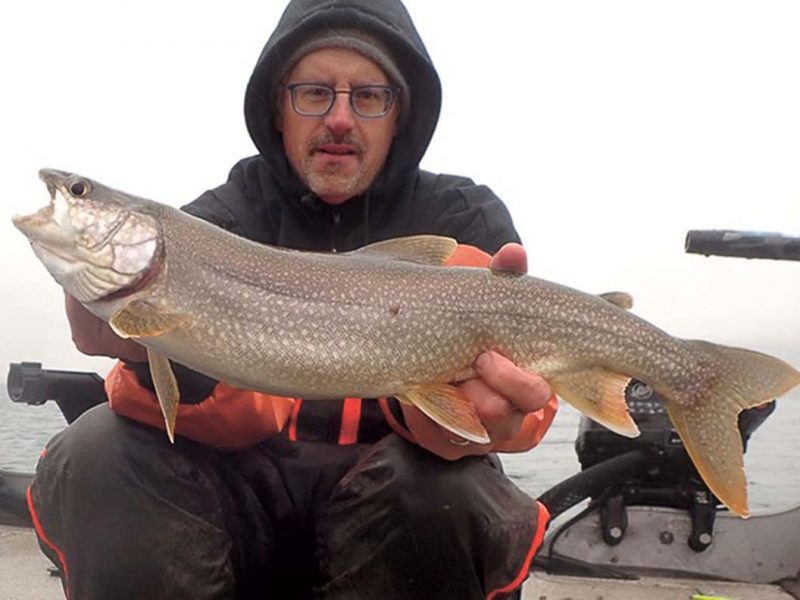
Pictured above: Lake trout bite all winter long for the anglers willing to brave the elements.
Over the last several years, mild winters have meant open water where there is usually ice. This was especially true on large, deep lakes. While tip-ups and ice-fishing gear collected dust, the year-round open water gave anglers unique opportunities to continue to fish these waters by trolling for trout.
(Note: On The Water is reader-supported. When you buy through links on our site, we may earn an affiliate commission.)
Several years ago, I heard that Round Valley Reservoir was completely open, so I decided to trek down there to see if I could connect with the rainbows, browns, and lake trout. As I motored across the deep basin in a flurry of snow while trolling a Michigan Stinger spoon through the 36-degree water, one of my rods ripped over and I thought to myself, “You’ve got to be kidding me!” The result was a chunky lake trout that had been 25 feet down in 90 feet of water. Successive passes around the same area resulted in another fish of similar in size. I was onto something!
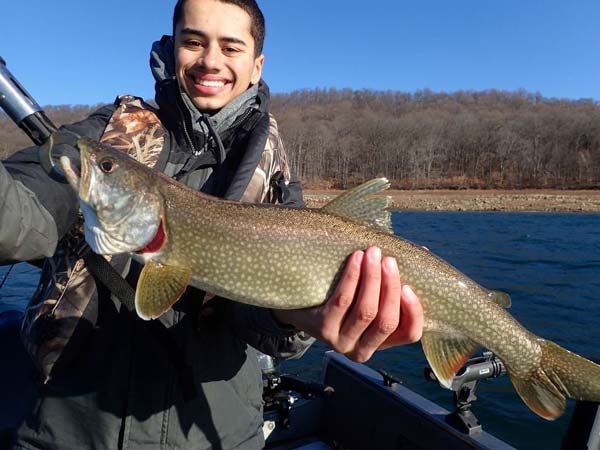
I do not own a pair of downriggers, so to get my baits down to the desired depths and in the faces of fish, I use leadcore line. Most types of leadcore line are metered so that fishermen can estimate the depth of their offering. The rule of thumb with most leadcore line is five feet of depth for every length of color (usually around 10 yards). With this information, an angler can take a small, floating minnow lure and let out six colors of line to get the bait down 30 feet. The nice part about fishing with the absence of a thermocline in the cold months is that many fish are not as deep as during the summer months. Anglers can capitalize on catching trout from 10 to 35 feet deep in ice-cold waters during December, January, and February.
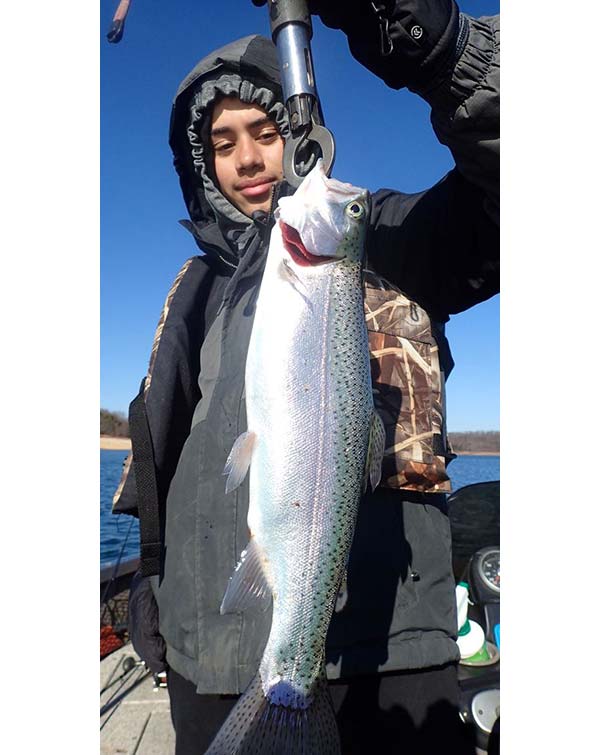
Tools of The Trade
To be successful at leadcore fishing, several relatively inexpensive components are necessary for the job. Long rods of 8½ to 10 feet with medium-light to medium power and moderate to slow actions are the tickets. These rods, which are made of a graphite/fiberglass composite, have a lot of spring to them and will be somewhat bent while trolling.

I use conventional reels with plenty of line capacity because leadcore has a thicker diameter when compared to monofilament or braided line. Reels with a line counter will help pinpoint the depth where the fish have been biting and allow you to set baits at that precise depth time after time.
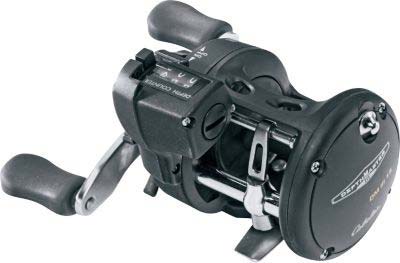
Leadcore lines testing in the range of 12-, 15-, 18-, or 27-pound test are perfect for winter applications. Before putting the leadcore on your reel, first add a backing. To the end of the leadcore, add a fluorocarbon leader from 6 to 10 feet long.
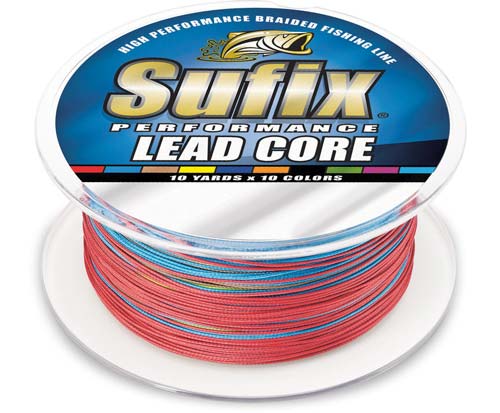
The best way to attach the leader to the line is with a Willis Knot or a barrel swivel. With the Willis Knot, carefully pull down the outer sheath on the leadcore, then clip off and remove a 6-inch piece of the lead. Tie a simple overhand knot up the lead core line, but don’t cinch it down. Insert the fluorocarbon leader into the empty sheath and push it up to the point that it stops. Finally, slowly work the overhand knot down to the juncture where the sheath and leader meet, and cinch it down.
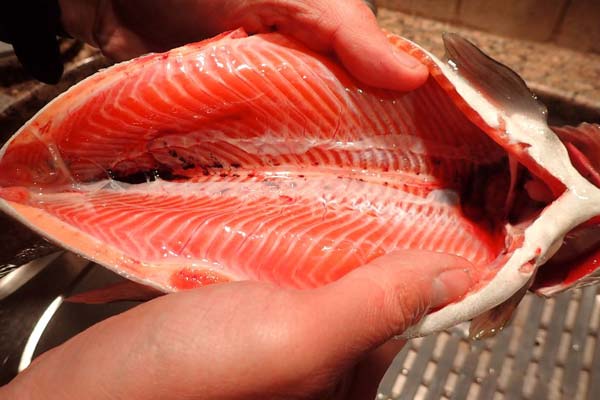
Another method is to tie an improved clinch knot with the empty sheath portion of the line onto a tiny barrel swivel that can be reeled through the rod guides and onto the reel. Tie your leader to the other end of the barrel swivel and you are set to go.
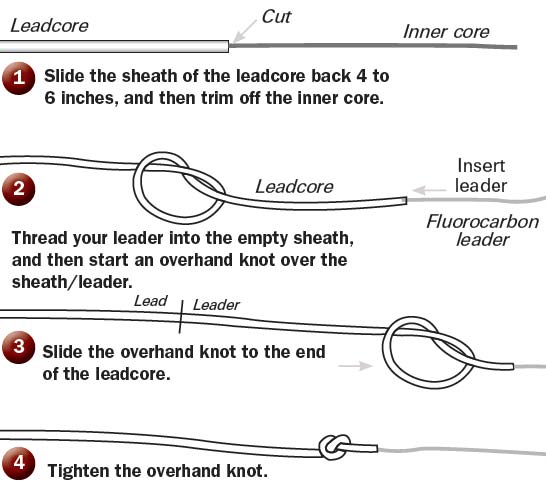
For winter trout, any small stickbaits, jointed minnows, crankbaits, and various styles, sizes, and colors of spoons get the nod as “trolling” baits. Try to match the forage in the lake in terms of size and color. Rapala Jointed Minnows and original 4- to 6-inch Rapalas in black and silver, blue and silver, chartreuse and silver, and orange and gold are often very effective. Michigan Stinger, Williams Wabler, and Sutton spoons also work well. I mix it up, and use two rods with minnow baits and two rods with spoons, then let the fish tell me what they want. Once one rod gets a strike, I change the others over to similar baits.


Leadcore Techniques
With water temperatures hovering just above freezing, slow is the ticket – speeds from 1 to 1.8 mph are optimal. Place the reel in free spool and slowly let out the leadcore with your thumb on the spool, while counting colors to obtain the desired target depth. Stagger the depths on each rod to find how deep the fish are holding, then set all the rods to that depth.
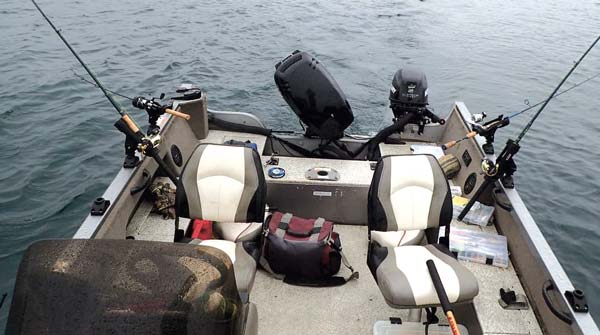
My winter trolling spread consists of two rods flatlined off the sides and two rods with lines attached to planer boards (also on the sides) and spread out wide to probe/troll a larger swath of water. With even more planer boards, you could troll as many as 10 rods depending on how much line is let out and the track of each planer board. Tangles can be an issue when a fish is hooked with many lines out, so it’s a good idea to have more than one angler in the boat to assist with clearing lines and removing boards once they have been reeled up to the rod.
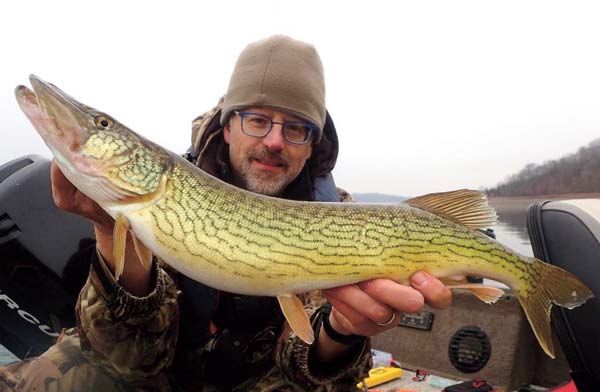
When trolling with leadcore, increasing your speed lifts the line, while decreasing speed causes it to sink. Use this to your advantage when trolling over variable depths and mid-lake structures. A strike will be telegraphed to the forgiving rod, causing it to rip over and bounce, but keep the boat moving. Do NOT cut the engine. This will reduce the risk of tangling or crossing over other lines, and increase the probability of getting another strike on another rod. On rods with boards attached, it is vital to understand how the board tracks and what happens to it when a fish strikes. Sometimes, the board will be pulled from its track to the side; other times, it will stop tracking correctly as if something is wrong. On boards with “tattle flags,” a red flag will either pop up or be pulled down on the planer board, depending when a fish strikes.

It is extremely important to keep a bend in the rod and maintain steady pressure while reeling in a hooked fish. I have had double-headers where a nice rainbow is on one line and a lake trout on the other.
Be sure to have a couple of setups spooled with monofilament or fluorocarbon because some fish can be caught in very shallow shoreline. Lake trout and rainbows can often be taken in 5 to 10 feet of water.
This winter, forget about winterizing your boat; while other fishermen are lamenting the lack of fishable ice, you could be catching trout!
This article was originally published online in December 2018.
Related Content
5 on “Winter Trout Trolling”
-
LOU GREAT ARTICLE OTW, ANOTHER WAY TO SCORE BIG ON UNFROZEN LAKES IN WINTER IS USING WHAT THEY CALL JIGG JIGG BOXES THAT MOVE YOUR RODS BACK AND FORTH WHILE TROLLING DOWN THE LAKE . WHAT ALSO WORKS WELL IS JERKING A GRAY GHOST STREAMER MY FAVORITE . FISH ON !
-
Pixie I like naked fishing
-
LOU WATCH OUT FOR THOSE FLYING HOOKS PIXIE .
-
Tommy WHY R U YELLING
-
-
-
Scott Schlemmer Being that the fish can be at any depth vertical snap jigging with a wide bodied spoon works great.
Leave a Reply